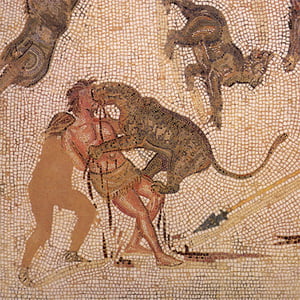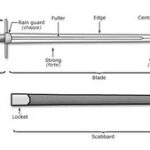Most of what we know about Roman Gladiators comes from Ancient literature, advertisements and artwork. Therefore, while we have a good idea of many distinct types of gladiators, we have a better picture of some than of others. Furthermore, there may have been more types that we do not even know about. With that being said, here is a list of some of the gladiators of which we have at least some knowledge. The number of them and their functions may surprise you.
Roman Gladiator Types: Thraeces
Thraeces fought using a sica (a curved sword). They were protected with a visored helmet and full armbands, possibly on just the right arm. They also wore leg protection from the waist to above the knee and sometimes shin guards.
Roman Gladiator Types: Murmillions
Murmillions wore little to no armor. They were most likely armed with either a club or one of the various types of swords that gladiators used. Murmillions are mentioned quite a bit in written Ancient Roman history. However, the above tidbits are about the extent of our knowledge of them.
Roman Gladiator Types: Retiarii
Retiarii were ‘net men.’ They were the only gladiators to fight with no helmet. They wore a one-sleeved tunic, leggings and a cumberbund. Retiarri also had a protective shoulder pad on the left shoulder. They carried a trident and dagger, along with their net.
It was a Retiarii’s job to snare their opponent with their net. A Retiarii who could not use his net successfully was considered an embarrassment, possibly a dead one.
Roman Gladiator Types: Secutores
Secutores or “pursuers” wore heavy armor and carried heavy weapons. They had a large helmet and the chest, legs and shoulders were covered in armor. They carried a sword and a shield.
Roman Gladiator Types: Essadarii
Essadarii gladiators fought from chariots and on foot. They were given projectile weapons to fire from their position on the chariot. These gladiators often fought in pairs. One would steer the chariot while the other fought.
Roman Gladiator Types: Bestiarii
Bestiarii or ‘beast men’ would be sent into the arena in the morning. They were pitted against wild animals, such as elephants and predatory cats. While this was not the best of jobs, the Bestiarii often defeated the animals and survived. We know that thousands of animals that are rare today died at the hands of Bestiarii.
Roman Gladiator Types: Dimachaeri
Dimachaeri were gladiators that fought with two swords, commonly sica. They wore a light helmet as well as leather leg and arm guards.
Roman Gladiator Types: Equites
Equites were gladiators that fought on horseback. The term was also used for Ancient Roman equestrian soldiers. They would only compete against other Equites. They would fight mounted and/or dismounted.
Equite gladiators carried a round shield, a short sword and a lance. They wore tunics that were belted above their knees, a small helmet and their lower legs wrapped in linen for protection.
Roman Gladiator Types: Hoplomachi
Hoplomachi (originally known as Samnites) were big, strong, slow and heavily armored combatants. They fought with a gladius sword and a 6-foot lance known as a hasta. Hoplomachi wore large, visored helmets, a greave on the lower left leg and their entire right arms were wrapped in either linen or leather. They also carried a small bronze shield.
Roman Gladiator Types: Laquerii
Laquerii carried a rope/noose that was comparable to a lasso. They used it to snare their opponent.
Roman Gladiator Types: Provocatores
Provocatores wore a distinct, not crested helmet. They also wore a breastplate, a greave on the lower left leg and the right arms were wrapped in linen or leather. Provocatores carried a rectangular body shield. They carried a gladius sword.
Provocatores were responsible for provoking each other for the crowd’s amusement. They typically fought against other Provocatores.
Roman Gladiator Types: Andabatae
Andabatae wore only a loincloth and a helmet with no eyeholes. They carried a gladius sword.
Roman Gladiator Types: Praegenarii
Praegenarii are the gladiator arena’s version of a rodeo clown. They would go in between acts and as openers, to entertain the crowd. They would wear gladiator armor, but they only carried wooden weapons. Theirs was not a dangerous job.
Judging by the descriptions above, being a gladiator was a dangerous and difficult job. However, it was not without its rewards. Many of these men were condemned criminals or slaves. Being a gladiator paid well; it brought them fame and for some, it might even bring them freedom. Of course, freedom sometimes came to the gladiator in the form of death, but not always.
Sources
Roman Gladiator Types, retrieved 4/14/10, unrv.com/culture/roman_gladiators.php
Provocatores, retrieved 4/14/10, roman-colisseum.info/gladiators/provocatores.htm
Hoplomachi, retrieved 4/14/10, roman-colisseum.info/gladiators/hoplomachi.htm
Equites, retrieved 4/14/10, uchicago.edu/~grout/encyclopaedia_romana/gladiators/lanista.html
Matz, David, Daily Life of the Ancient Romans, pages 104-108, 136, Greenwood Press, 2002






